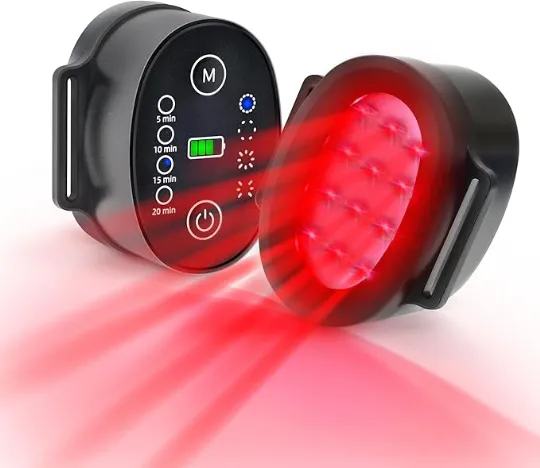Finding the Right Balance for Red Light Therapy Dogs
Exactly How Red Light Therapy Can Enhance Your Dog's General Well-Being
Red Light Therapy has actually emerged as a promising choice for improving canine wellness. This non-invasive treatment boosts cellular task and promotes healing in pets experiencing from different ailments. Lots of animal proprietors report visible advantages, including discomfort alleviation and improved flexibility. Nevertheless, recognizing the underlying devices and potential applications is crucial. What specific conditions can it resolve, and how can it be safely incorporated right into a dog's care programs? The solutions may amaze you.
Comprehending Red Light Therapy: What It Is and Just how It Works
Although red light therapy has gotten appeal in human medicine, its application for canines is progressively identified for its possible benefits. This non-invasive treatment uses certain wavelengths of light, commonly in the red and near-infrared spectrum, to stimulate cellular function. The underlying principle involves the absorption of light by mitochondria, which increases ATP production and improves cellular metabolic process.
Because of this, red light therapy promotes enhanced circulation and aids in tissue repair work. The therapy is delivered with gadgets such as lasers or LED panels, which can be directed at particular areas of a canine's body. Treatment sessions are usually short, making it a convenient option for pet proprietors.
Recognizing this modern technology's devices can aid caretakers make notified choices about their dog's healthcare. As study remains to develop, the interest in red light therapy as a corresponding therapy technique for various canine conditions is most likely to grow.

Advantages of Red Light Therapy for Dogs
Red light therapy uses several considerable benefits for pet dogs, consisting of efficient discomfort relief and an increased recovery process. This therapy can improve mobility and versatility, making it specifically important for maturing or injured family pets. As even more animal proprietors look for alternative treatments, recognizing these advantages ends up being significantly important.
Pain Alleviation Applications
Several canine owners are transforming to red light therapy as an encouraging service for easing discomfort in their pets. This non-invasive treatment uses details wavelengths of light to penetrate the skin, promoting cellular task and lowering inflammation. Canines struggling with persistent problems such as joint inflammation, hip dysplasia, or post-surgical pain might experience significant relief through this therapy. Research studies suggest that red light therapy can improve blood flow, aiding to supply essential nutrients to affected areas, even more contributing to pain reduction. Furthermore, it may assist to reduce the reliance on pharmaceutical painkiller, which typically include unfavorable adverse effects. Consequently, lots of vets are progressively suggesting red light therapy as a risk-free and efficient alternative for managing pain in dogs.

Accelerated Healing Process
The advantages of red light therapy prolong beyond pain relief, playing a vital function in accelerating the recovery procedure for canines. This cutting-edge therapy promotes mobile regeneration, boosting the manufacturing of ATP, which enhances power accessibility for recovery cells. Furthermore, red light therapy increases blood flow, causing improved oxygen and nutrient distribution to hurt locations. This increased blood circulation not only help in faster healing but likewise reduces swelling, a common obstacle to recovery. Furthermore, the therapy urges collagen production, critical for tissue fixing and regeneration. On the whole, by helping with these biological procedures, red light therapy considerably reduces healing times, permitting dogs to go back to their regular activities a lot more quickly and with higher vigor.
Improved Movement and Adaptability
Enhanced movement and adaptability are significant benefits of red light therapy for pet dogs, specifically for those dealing with joint discomfort or rigidity. This non-invasive treatment utilizes certain wavelengths of light to pass through tissues, promoting boosted blood circulation and reducing inflammation. As an outcome, pets often experience remedy for discomfort linked with joint inflammation, hip dysplasia, or post-surgical recuperation. Regular sessions can stimulate cellular repair work and improve muscular tissue feature, permitting dogs to regain their natural series of movement. Owners have reported obvious renovations in their pet dogs' ability to run, jump, and engage in activities they once enjoyed (Red Light Therapy Dogs). Ultimately, red light therapy not only helps reduce pain however also adds to an extra active and fulfilling way of living helpful resources for dogs, boosting their total top quality of life
Problems That Can Be Cured With Red Light Therapy
Although red light therapy has actually gotten appeal in different fields, its application in veterinary treatment, specifically for pet dogs, has shown promise in dealing with a series of problems. This non-invasive therapy technique is believed to assist in easing discomfort and inflammation related to joint inflammation, helping older dogs reclaim wheelchair. Furthermore, it has actually been used to assist in the recovery of wounds, burns, and surgical lacerations, promoting faster recovery times.
Skin disease, such as dermatitis and locations, may also respond positively to red light therapy, decreasing irritability and encouraging much healthier fur development. In addition, the therapy can be useful for dogs struggling with conditions like hip dysplasia, ligament injuries, and muscle pressures. By boosting cellular repair service and enhancing flow, red light therapy offers an alternative strategy to enhancing the total well-being this article of pet dogs, giving relief and advertising a far better high quality of life.
The Scientific Research Behind Red Light Therapy
Red light therapy operates the principle of photobiomodulation, which includes the application of specific wavelengths of light to promote mobile procedures. These wavelengths, generally varying from 600 to 1000 nanometers, pass through the skin and are absorbed by mitochondria, the energy-producing elements of cells. This absorption improves ATP manufacturing, leading to enhanced power schedule for cellular functions.

Studies recommend that red light therapy may additionally regulate immune actions and support overall mobile health and wellness. By harnessing these organic systems, red light therapy provides a non-invasive therapy choice that can contribute substantially to a pet dog's well-being and recuperation from different conditions.
How to Integrate Red Light Therapy Into Your Dog's Regular
Integrating red light therapy right into a canine's regimen can i was reading this be a straightforward procedure, provided that family pet proprietors approach it with care and uniformity. Initially, selecting an ideal device is essential, as alternatives range from handheld devices to larger panels. Owners must begin by presenting the therapy slowly, enabling their pets to accustom to the light direct exposure. Procedure can be scheduled for about 10 to 20 mins, preferably a couple of times a week, depending upon the pet dog's demands and the guidance of a veterinarian
Establishing a comfy setting is essential; utilizing a quiet space where the canine feels kicked back can boost the experience. Throughout the sessions, proprietors can involve their pets with relaxing voices or gentle petting to produce a soothing environment. Checking the pet's feedback is crucial to guarantee the therapy is satisfying and helpful, inevitably aiding to enhance their general wellness.
Security Considerations and Precautions for Red Light Therapy
When thinking about red light therapy for canines, safety should always be a leading concern to ensure a positive experience. Animal owners must consult a vet prior to starting any therapy, specifically for pets with pre-existing problems or those taking medicines. It is vital to choose tools especially created for pets, as human tools may not appropriate.
Proper eye defense is crucial; both the canine and the handler should put on goggles to shield their eyes from possible damage. Additionally, sessions need to be kept an eye on closely to stay clear of overexposure. It is advisable to begin with shorter sessions and progressively boost duration based upon the dog's feedback.
Owners need to likewise observe their pets for any type of signs of pain or adverse responses during and after therapy. By following these security factors to consider, red light therapy can be a secure and useful alternative for enhancing a pet's well-being.
Often Asked Questions
Exactly how Often Should I Utilize Red Light Therapy on My Dog?

Can Red Light Therapy Change Typical Vet Therapies?
Red light therapy must not replace conventional veterinary treatments. While it might enhance treatments by promoting healing and reducing pain, consulting a vet continues to be necessary for complete care and dealing with underlying wellness problems in canines.
Are There Any Kind Of Adverse Effects of Red Light Therapy for Dogs?
Red light therapy for pet dogs typically has minimal adverse effects, such as short-lived skin inflammation or warmth at the therapy website. Most pets endure the therapy well, but monitoring for any kind of unusual reactions is suggested.
What Is the Suitable Period for every Red Light Therapy Session?
The optimal period for every red light therapy session generally varies from 10 to 20 minutes, relying on the pet dog's specific demands and condition. Appointment with a veterinarian is advised to tailor the therapy appropriately.
Is Red Light Therapy Ideal for All Canine Types?
Red light therapy is typically ideal for many pet breeds. Nevertheless, individual health and wellness problems and sensitivities might affect its applicability. Consulting a veterinarian ensures the therapy is safe and beneficial for every specific canine.
Several dog owners are transforming to red light therapy as a promising service for relieving pain in their animals. Boosted mobility and versatility are considerable advantages of red light therapy for dogs, particularly for those experiencing from joint discomfort or rigidity. Red light therapy runs on the principle of photobiomodulation, which involves the application of particular wavelengths of light to boost mobile procedures. Research indicates that red light therapy can promote healing, decrease swelling, and relieve discomfort in dogs. Red light therapy for dogs typically has very little side impacts, such as momentary skin soreness or heat at the therapy website.